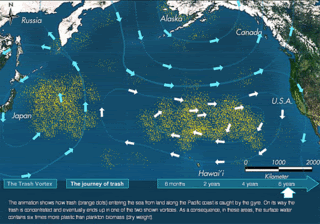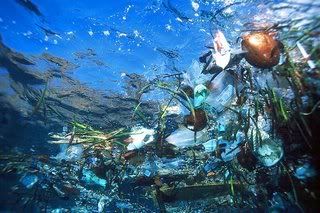(click the pic to read it)
To remind us what those who love the scientific process can do:
This month heralds a world-changing scientific breakthrough as a teenage prodigy has developed a new way to decompose plastic bags in just three months! A 16 year old named Daniel Burd conducted his experiment as a science fair project, and ended up with a revolutionary solution to the plastic plague that has laid waste to ecosystems around the world. By isolating the microorganisms that break down plastic, Burd’s research has yielded an industrially scalable way to cinch closed the material’s millennium-spanning life-cycle.I posted this in November of '07 and deserves a reprint:
Plastic bags, once icons of customer convenience, cost more than 1.6 billion barrels of oil per year and leave the environment to foot the bill. The statistics are scary - each year the world produces 500 billion bags, and Earth Resource Foundation states that “all the plastic that has been made is still around in smaller and smaller pieces.” Meanwhile the UN Environment Program estimates that there are 46,000 pieces of plastic litter in every square mile of ocean, and a swirling vortex of trash twice the size of Texas has spawned in the North Pacific.
Making a new continent: One plastic bag at a time In the broad expanse of the northern Pacific Ocean, there exists the North Pacific Subtropical Gyre, a slowly moving, clockwise spiral of currents created by a high-pressure system of air currents. The area is an oceanic desert, filled with tiny phytoplankton but few big fish or mammals. Due to its lack of large fish and gentle breezes, fishermen and sailors rarely travel through the gyre. But the area is filled with something besides plankton: trash, millions of pounds of it, most of it plastic. It's the largest landfill in the world, and it floats in the middle of the ocean.It's the world's biggest landfill and it's in the Pacific Ocean.
The gyre has actually given birth to two large masses of ever-accumulating trash, known as the Western and Eastern Pacific Garbage Patches, sometimes collectively called the Great Pacific Garbage Patch. The Eastern Garbage Patch floats between Hawaii and California; scientists estimate its size as two times bigger than Texas [source: LA Times]. The Western Garbage Patch forms east of Japan and west of Hawaii. Each swirling mass of refuse is massive and collects trash from all over the world. The patches are connected by a thin 6,000-mile long current called the Subtropical Convergence Zone. Research flights showed that significant amounts of trash also accumulate in the Convergence Zone.



2 comments:
You should check out the RepRap project by the way. And we should stop using petroleum-based plastics anyhow.
Off to google...
Post a Comment